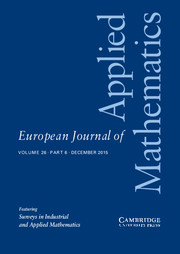The special relationship between mistletoe, birds and mathematics
Mistletoe is a plant associated with winter and Christmas primarily in Western cultures – particularly in the United States, Canada, and Europe. Mistletoe is mentioned in the lyrics of Christmas songs, printed on Christmas cards, and hung indoors to decorate for the festive period. The plant is often hung in doorways and above entrances during the Christmas holiday period, recognised as a symbol of love and friendship due to the tradition of kissing underneath mistletoe. But, how does mistletoe grow? How does mistletoe spread? And, curiously, how does this link to the latest mathematical research?
Mistletoes are evergreen aerial stem-parasites plants that grow berries
The plant grows on the branches of host trees and is recognisable in clusters. It can be easily seen once its host has lost its leaves during the winter seasons. According to the Woodland Trust, mistletoe is commonly found on apple and lime trees, as well as hawthorn and poplar trees.
Mistletoes and birds have a unique relationship, whereby both species rely on each other
The mistletoe relies on the bird to disperse its seeds, while birds benefit from the mistletoe’s berries as a food and water source to obtain important nutrients. Without birds, adult mistletoes can only spread in a small area. This means that birds flight is hugely significant to the movement of their propagules into safe germination sites to spread its growth. Recent research by mathematicians in European Journal of Applied Mathematics explains that birds contribute to the large-scale invasion of mistletoes in new territories.
Applying mathematics to explore the special relationship between mistletoe and birds
Authors Juan He, Guo-Bao Zhang and Ting Liu describe this special relationship in their latest research paper ‘Propagation dynamics of a mutualistic model of mistletoes’:
‘It is well known that without birds, the adult mistletoes can only spread in a small area. However, with the nonlocal movements of birds, the mistletoes can invade into new large territories. As such, it is a very interesting problem to model the spatial invasion process of the mistletoes. One way to mathematically characterise this dynamics of the process is travelling wave solution’ (He et al. 2023).
Published in December 2023, the article studies the propagation dynamics of a mutualistic model of mistletoes and birds with nonlocal dispersal. They establish that the dispersive model has an asymptotic spreading speed in the sense that an initial distribution of birds and mature mistletoes can asymptotically not be transported faster than with this speed, but is preserved and dispersed within the space reachable in a given time. In order to show the existence of this asymptotic speed and prove upper and lower bounds for it, the authors apply existing results on the asymptotic speeds of spread for monotone semiflows.
The authors further examine the wavefront propagation of the dispersion model for mistletoes and birds – that is, the existence of special solutions in which mass is transported homogeneously at a fixed speed. It turns out that, by exploiting further existing results on travelling waves of semiflows, it can be shown that the minimal speed at which wavefront solutions may propagate coincides with the model’s asymptotic speed.
So, what does this new research highlight?
The research by Juan He, Guo-Bao Zhang and Ting Liu highlights the importance of understanding the propagation dynamics of mutualistic relationships. It showcases the generalization from diffusion models to macroscopically more suitable nonlocal dispersion models.
By understanding the relationship between the birds and mistletoe, the research presented in European Journal of Applied Mathematics can help environmentalists to learn how to better protect and preserve these important species and the ecosystems that they inhabit.
‘Propagation dynamics of a mutualistic model of mistletoes and birds with nonlocal dispersal’, by Juan He, Guo-Bao Zhang and Ting Liu. This open access paper is part of Partial Differential Equations in European Journal of Applied Mathematics. Thanks to open access, this paper is free to read, download, and share.
Since 2008 EJAM surveys have been expanded to cover Applied and Industrial Mathematics. Coverage of the journal has been strengthened in probabilistic applications, while still focusing on those areas of applied mathematics inspired by real-world applications, and at the same time fostering the development of theoretical methods with a broad range of applicability. Survey papers contain reviews of emerging areas of mathematics, either in core areas or with relevance to users in industry and other disciplines. Research papers may be in any area of applied mathematics, with special emphasis on new mathematical ideas, relevant to modelling and analysis in modern science and technology, and the development of interesting mathematical methods of wide applicability.





